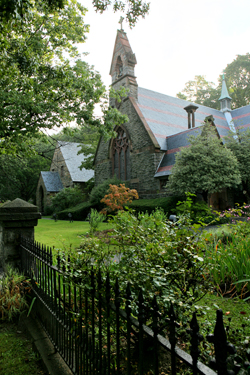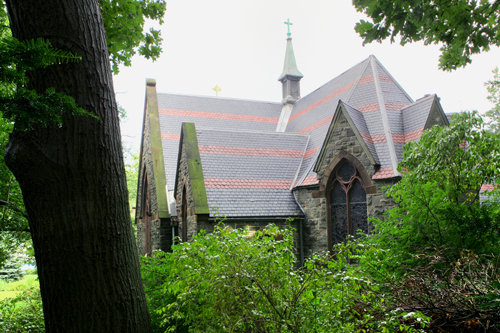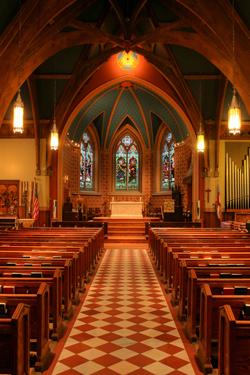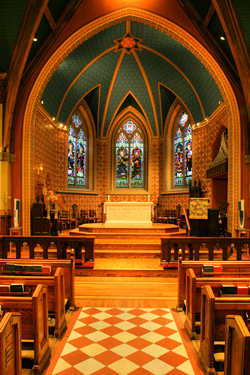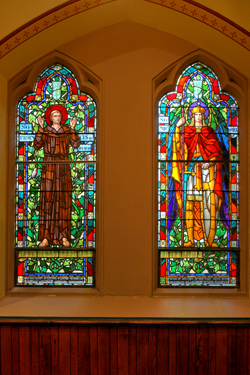Christ Church
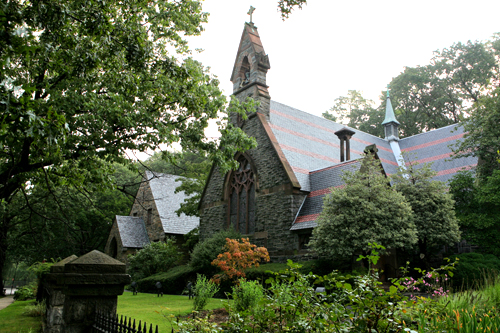
5030 Riverdale Avenue
Richard Mitchell Upjohn
In 1864, in what is today the Bronx, a group of residents drew up an agreement to build a church “appropriate to the surrounding circumstances and the wealth of the neighborhood.” The “surrounding circumstances” were pastoral, a wooded piece of the Babcock estate on upper Riverdale Avenue, at the foot of a road leading uphill to Riverdale Institute, a newly-established women’s school. The “wealth of the neighborhood” was considerable. In the 1830’s, well-off Manhattanites had begun to buy up farmland along the Hudson north of the city for their rural retreats. Steamboats and then the Hudson River Railroad offered the opportunity of a daily commute to the counting house, attracting active businessmen. In 1853, some of these bought land for the first development to be named “Riverdale,” a set of villas along Palisade Avenue convenient to a train depot and dock on the river (at today’s 254th Street). They were joined in the 1860's by “The Park-Riverdale,” grander homes built for the “merchant princes,” bankers, and industrialists who were reaping the benefits of a war economy. For their out-of-town, weekend worship, Episcopalians in the new communities subscribed a full $44,000 toward the construction of Christ Church.
Their mandate for rural opulence was easily within the grasp of the Victorian neo-Gothic style of architecture, in which ecclesiastical designs of medieval England—including its simple country chapels—met up with the rich polychromy, variously textured materials, hand-craftsmanship, and ornamental art work commended in the influential criticism of John Ruskin. As a result, New York’s leading “Goths,” James Renwick, Jr., and Upjohn and Son, were to be found at work on Riverdale churches in the ‘60s. Christ Church was the creation of Richard Mitchell Upjohn, who busily brought up to date the more naive Gothic Revival work of his father, as seen for instance in Manhattan’s Trinity Church of two decades earlier.
In form, Christ Church replicates what may be found in many English rural parishes: a long nave with a transept and apse beyond; the roof steeply pitched, leaving no room for a clerestory, with a flèche or small spire at the crossing; a gabled entry porch to the south, near the west end; pointed stained-glass windows in the semicircular apse, along the nave, and on the transept ends, with a broad triple window with stone tracery in the center of the west wall; above it on the roof ridge, in place of a tower, a gable bell-cote. (The connected parish house to the north is by Dwight James Baum [1923].)
Despite the simple plan, Upjohn attends to Ruskin’s pronouncement that costly materials and efforts of craftsmanship are of the greatest importance in church architecture, especially in an age always congratulating itself for doing things quickly and cheaply. To take in the richness of detail, a visitor standing on Riverdale Avenue can focus on Christ Church’s west end. The materials: randomly coursed rock-faced ashlars of dark granite, set off by light mortar, with belts, cornices, and moldings of smooth red sandstone. The window: stained glass, divided by dark red tracery into three sections, crowned with one large and two smaller wheels of trefoils. A hood molding over the pointed arch rests on carved corbels. The wall: crossed by wide belt courses. A molding marks the edge of the raking cornice, and leads to a terracotta mandorla (almond-shaped halo) with a cross-and-miter escutcheon at the peak of the gable. The bell cote: a fascinating flat belfry, with small gables perched on its shoulders. The roof: grey, banded with bright red-orange slates.
Inside, there’s much more to savor--for instance, a blue-painted wooden ceiling, stenciling in Victorian style, important stained glass, and memorials to parishioners Fiorello LaGuardia and Lou Gehrig.
David Bady
Photographs:
Tom Stoelker and Kareema Hussein

